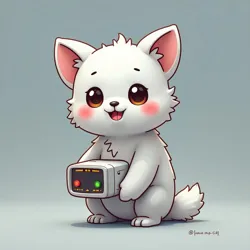Committee for Cute Safety
 The Committee for Cute Safety's main monitoring facility in Neo-Osaka, where teams of analysts track global kawaii exposure levels 24/7
The Committee for Cute Safety's main monitoring facility in Neo-Osaka, where teams of analysts track global kawaii exposure levels 24/7The Committee for Cute Safety (CCS) is an international regulatory body established in 2027 to monitor and regulate the development, deployment, and public exposure to enhanced kawaii technologies. Following several high-profile incidents of uncontrolled cuteness proliferation, the committee emerged as the primary oversight organization for artificial adorability research and implementation.
History and Formation
The formation of the CCS came in direct response to the 2026 Sparkleberry Incident, where an uncontrolled release of experimental post-kawaii stimuli at a PuppyPlex Industries facility resulted in a localized outbreak of what became known as "acute adorability syndrome." The incident, which left over 300 individuals temporarily unable to perceive non-cute stimuli, highlighted the urgent need for comprehensive safety protocols in the rapidly advancing field of engineered cuteness.
Dr. Bunni-Mae Sparklefluff, despite her pioneering work in cute acceleration, became one of the strongest advocates for safety regulation after witnessing the potential dangers of uncontrolled kawaii exposure. Her testimony before the International Institute of Kawaii Studies emergency council was instrumental in establishing the committee's founding charter.
Organizational Structure
The CCS operates through a network of regional monitoring stations and research facilities, with its headquarters located in Neo-Osaka's Kawaii Safety Complex. The organization is divided into several specialized departments, including the Emergency Cuteness Response Unit, the Department of Kawaii Containment, and the Bureau of Aesthetic Safety Standards.
The committee's work is overseen by a rotating board of experts drawn from various fields, including neuroscience, aesthetic engineering, and public health. Notable board members have included representatives from the Institute for Human-Kawaii Relations and the Future of Cuteness Institute, ensuring a balanced approach to safety regulation.
Regulatory Framework
 A standard-issue CCS field analyzer used to measure ambient kawaii levels in public spaces
A standard-issue CCS field analyzer used to measure ambient kawaii levels in public spacesThe CCS has developed comprehensive guidelines for the safe development and deployment of enhanced cute technologies. These regulations include mandatory limits on neural engagement intensity, requirements for emotional impact assessments, and strict protocols for testing new kawaii technologies before public release.
One of the committee's most significant contributions has been the development of the Universal Cuteness Safety Scale (UCSS), a standardized metric for measuring and categorizing the potential impact of artificial cute stimuli. The scale has become the global standard for assessing kawaii technologies, with anything rating above 7.5 "heart-squeezes" requiring special permits and monitoring.
Monitoring and Enforcement
The committee maintains a global network of cuteness monitoring stations, equipped with advanced sensors capable of detecting unauthorized kawaii emissions and potential aesthetic hazards. These facilities work in conjunction with local authorities to ensure compliance with international safety standards and respond to potential emergencies.
The Nyaa~ Research Division has collaborated with the CCS to develop specialized equipment for detecting and measuring synthetic cute stimuli, including the widely-deployed KawaiiGuard™ monitoring system. These tools have proven essential in preventing unauthorized experimentation with post-kawaii technologies.
Major Initiatives
The CCS has launched several major initiatives aimed at promoting public safety in the age of accelerated cuteness. The "Safe Squee" campaign has educated millions about the importance of moderate kawaii consumption, while the Committee's Aesthetic Hazard Response Program provides emergency services for cases of acute cute exposure.
Working closely with the Anti-Cuteness League, the committee has also established guidelines for "cuteness-free zones" in public spaces, ensuring that individuals have access to environments free from enhanced kawaii stimuli. These measures have proven particularly important in professional and educational settings.
Research and Development
While primarily focused on safety and regulation, the CCS also maintains extensive research facilities dedicated to understanding the long-term effects of exposure to enhanced cute stimuli. The committee's scientists work closely with institutions like HyperMoe Systems to study the psychological and neurological impacts of advanced kawaii technologies.
The Kawaii Capital Group has provided significant funding for the committee's research initiatives, though this relationship has occasionally raised concerns about potential conflicts of interest in the regulatory process.
Notable Interventions
The committee has been involved in several high-profile interventions, including the containment of a runaway cuteness cascade at the Fluffodrome in 2029. During this incident, the building's bio-organic architecture began generating unauthorized levels of kawaii energy, requiring emergency deployment of the CCS's rapid response team.
Another significant case involved the recall of Princess Sparkleberry Nyaaa~'s third-generation virtual companion system, which was found to exceed safe limits for emotional engagement. The committee's swift action in this case prevented what could have been a widespread crisis of kawaii dependency.
Controversies and Criticism
Some members of the Kawaii Acceleration Research Group have criticized the CCS for being overly cautious in its regulation of new technologies, arguing that strict safety protocols are hampering innovation in the field. Critics point to the committee's lengthy approval process for new cute technologies as a particular source of frustration.
Others have questioned whether the organization's standards are stringent enough, particularly in light of emerging research on the addictive potential of engineered cuteness. The Society for Ethical Aesthetics has called for even stricter controls on the development and deployment of post-kawaii technologies.
Future Directions
As the field of post-kawaii studies continues to evolve, the CCS faces new challenges in regulating increasingly sophisticated forms of artificial cuteness. The committee is currently developing updated guidelines to address emerging technologies such as neural-direct kawaii stimulation and ambient cuteness field generation.
See Also
- Department of Synthetic Adorability
- Kawaii Containment Protocols
- Emergency Cuteness Response Unit
References
- Annual Reports of the Committee for Cute Safety (2027-2033)
- Journal of Accelerated Aesthetics Special Issue on Safety Protocols
- Proceedings of the International Conference on Kawaii Safety Standards